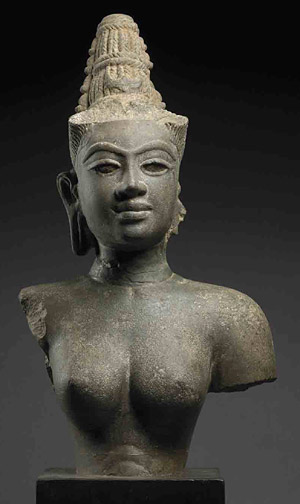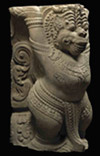
Devi Dong Duong Huong Que (province of Quang Nam)
Xth century Stoneware H. 40cm Ho Chi Minh-Ville
Vietnam History Museum Inv. BTLS.4420 |
|
MUSÉE NATIONAL DES ARTS ASIATIQUES
GUIMET
6, place d'Iéna 75016 Paris
INFORMATION:
Tel: 01 56 52 53 00
Fax: 01 56 52 53 54
Site: www.museeguimet.fr
HOURS:
Everyday except Tuesday, 10am to 6pm,
Closing call: 5.45 pm
ADMISSION PRICES:
Exhibition: Full price: 6,5 €
Concessions and Sunday: 4,5 €
Exhibition + Museum : 8 €
Concessions and Sunday: 5,5 €
Free under 18
CURATORSHIP:
Pierre Baptiste
Thierry Zéphir
PRESS CONTACT:
Hélène Lefèvre
Tel: 01 56 52 53 32
Fax: 01 56 52 53 54
email: helene.lefevre@culture.gouv.fr

|
This exhibition presents an exceptional group of 96 sculptures in stoneware, bronze and precious metal, that punctuate the history and illustrate the religions of ancient Champa, a kingdom that no longer exists but that was located in the past in what is today central and southern Vietnam. Among them, and for the first time, the master pieces of the two most important Vietnamese collections of Cham art: 48 pieces from the Da Nang Museum and 15 from the one in Ho Chi Ming City. Aside from these works of art, we can see 7 sculptures kept at the My Son site, in the province of Quand Nam, a selection of 23 pieces that belong to the Guimet Museum, 2 sculptures from the Rietberg Museum in Zurich an a work from the Museum in Lyons.
A history that remains badly known
The country’s history remains badly known in spite of the important studies that have been carried out based on inscriptions found in the temples, written both in Sanskrit and in former Cham.Various kingdoms florished in the small coastal plains surrounded by mountains from the sinuous coasts of Vietnam. The artistic testimonies that have survived to our era are usually brick temples –the kalans and of course various sculptures, haughty and distant cult statues adored in the sanctuaries, or elements of a rich –sometimes exhuberant but always original architectural setting.
Ancient India’s cultural heritage
The art of Chapa appears as one of the major expressions of South Eastern Asia’s ancient forms of art. It paved the way for very sensitive original creations in which ancient India’s cultural heritage is perfectly assimilated. As of its very first steps and the first centuries of our time, Champa art entered in the great concert of Indianized people of South Eastern Asia. Like its neighbors but in its own way, it made the religions and languages of classic India –Hinduism and Buddhism on the one hand, Sanskrit on the other – flourish in its own way.
Illustration: Part of architectural décor : Garuda overcoming the naga
Thap Mam (province of Binh Dinh) c. XII-XIII th cent.Stoneware. H. H. 109 cm
Inv. 41.30 - Musée de Da Nang, Vietnam
From its origins to its decline
The exhibition opens on the presentation of a few photos from the Charles Carpeaux foundation, tracing the rediscovery and the first studies led on the large Cham sites from 1902 to 1904. A selection of ancient molds from the ‘30s illustrates in ways of an introduction, certain inportant aspects of the Champa architecture. For the first time since their discovey in 1902-1903, the major works from the sites of Dong Duong –end of the IXth century- and My Son- VII-XIIIth centuries – are brought together. The chronological presentation of the works helps us follow the evolution of Cham statuary from the oldest pieces known to date –Vth century approximately- to the swan song –XVth century approximately –prior to Champa’s progressive decline up to its disappearance in the XIXth century.
PUBLICATION:
Catalogue of the exhibitpon, approximately 400 pages, nearly 270 color and black & white illusrations, co-edition RMN/ Musée Guimet : 49€
To see more illustrations, click on VERSION FRANCAISE at the top of this page
|









